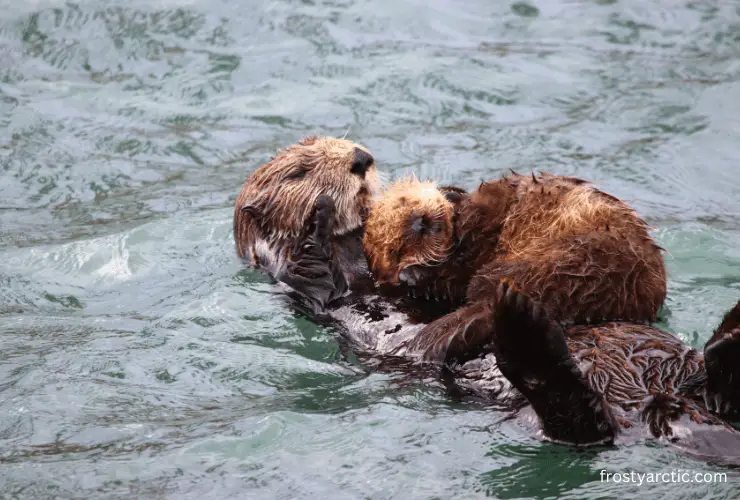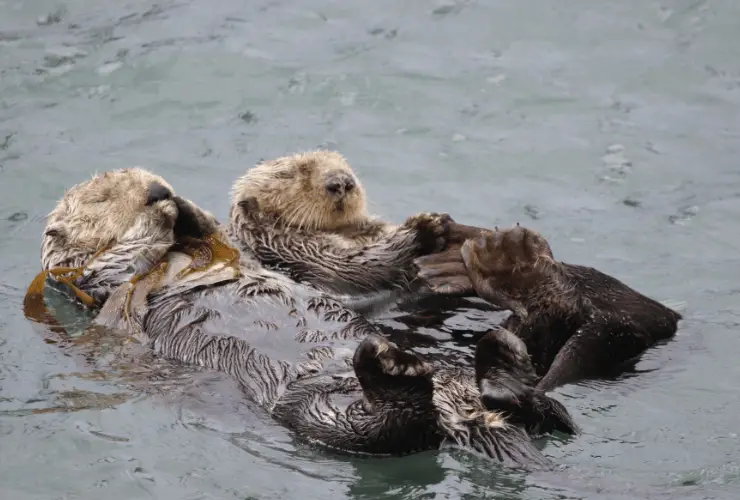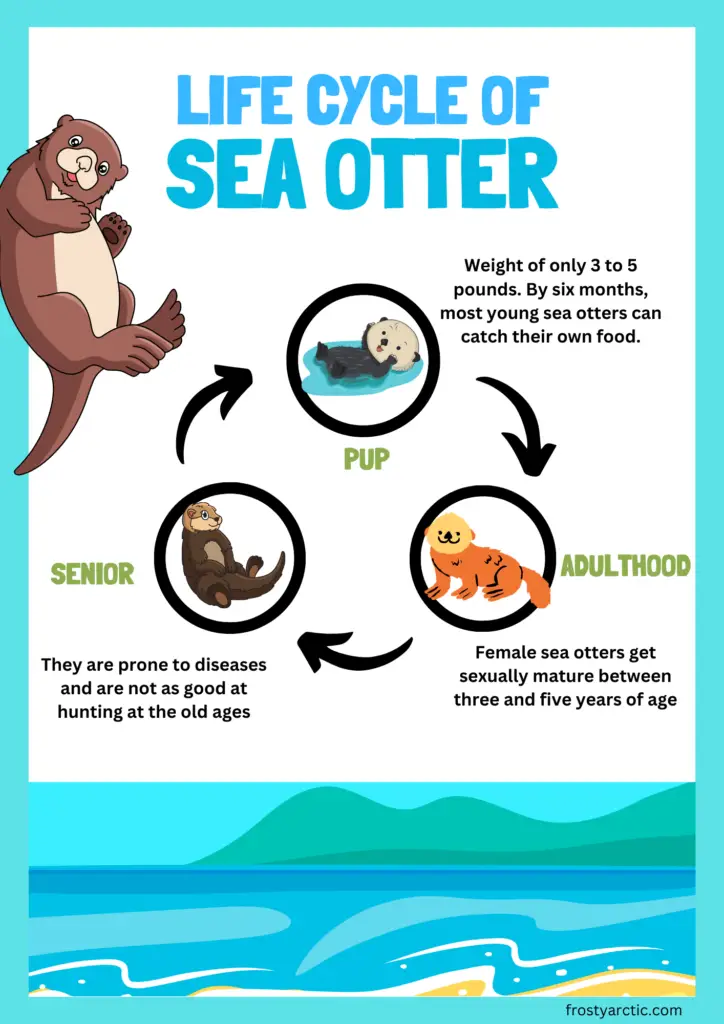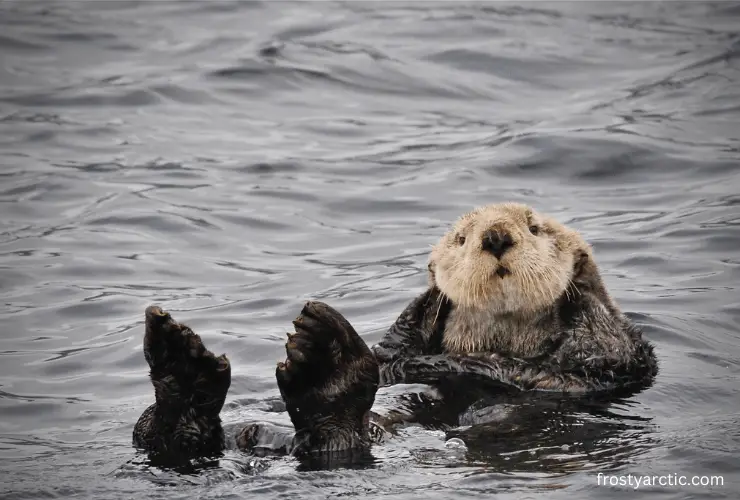Sea otters usually live about 10 to 20 years. The average lifespan of male sea otters in the wild is around 10 to 15 years. The lifespan of a female sea otter, on the other hand, is between 10 and 20 years.
But their lifespan can vary based on many factors. The environment they live in can play a big part. Wild sea otters face dangers like predators and human activities that can shorten their lives. But in safe, controlled environments like zoos or aquariums, they often live longer, sometimes even past 20 years.
Did you know? Despite the average life expectancy of sea otters being between 10 to 20 years, one record-breaking sea otter defied the odds and lived up to 28 years. Interesting, right?
But hold on! There’s much more to learn about sea otter’s life, so keep reading. We will explore their life in the wild, compare it to life in captivity, and discover how these resilient creatures navigate through each stage of their existence.
How Long Do Sea Otters Live in the Wild?
According to the U.S. Geological Survey (USGS), wild sea otters, on average, live between 10 and 20 years.
The Lifespan of Male & Female Sea Otters
Did you know there is a noticeable difference in the lifespan of male and female sea otters?
According to the COSEWIC, female sea otters typically outlive males. They can live up to 15 to 20 years. Conversely, male sea otters have a bit of a shorter run, averaging around 10 to 15 years.
Do you know why? Well, scientists are still trying to figure it out. But they do have some theories. They believe the strenuous nature of mating rituals and territorial fights among males could be factors that lower their lifespan.
What Factors Affect the Lifespan of Sea Otters in the Wild?

Let’s break down the factors impacting how long sea otters live in the wild.
● Predation
First off, predation is a big one. Sea otters face threats from many predators that pose a big danger, especially to younger and weaker sea otters. They can drastically cut short their lifespans.
● Genetics
Then, there’s genetics. Studies have shown that some sea otters’ genes help them live longer. For example, female sea otters often live longer than males. This may be because females have a higher survival rate during their reproductive years.
But genetics can also work against them. Some sea otters might have gene mutations that make them more prone to sickness and health problems, which can shorten their lives.
● Diet
Next, we’ve got a diet. Sea otters are meat-eaters. The quality and quantity of their food matter. If they eat a lot of fat and protein, they tend to live longer than those that consume carbs. A diet rich in fats and proteins gives them all the necessary nutrients to stay healthy and survive.
● Environmental Factors
The environment where sea otters live also matters. If sea otters live in polluted areas or places with many environmental hazards, they could face health problems that shorten their lifespan. Changes in ocean temperature or other environmental shifts can also make it harder for them to find enough food, impacting their overall health and survival.
How Long Do Sea Otters Live in Captivity?
In captivity, sea otters generally have a longer lifespan. According to the AZA Marine Mammal TAG (2019), sea otters in zoos and aquariums can live up to 25 years with the proper care and environment.
A controlled environment can wipe out many dangers that shorten their lifespan in the wild. Predators, human-induced pollution, and food scarcity are virtually non-existent.
Captive sea otters receive regular meals and medical care and live in environments that mimic their natural habitats. This consistency and care can enhance their longevity significantly.
● Challenges of Captivity
While captivity can increase a sea otter’s lifespan, it’s not without its challenges. Sea otters are highly active animals, requiring physical and mental stimulation to remain healthy.
To keep these intelligent mammals engaged, zoos and aquariums must provide appropriate enrichment, including toys, puzzles, and foraging tasks. Failure to do so can lead to stress, adversely affecting their health and longevity.
What is the Longest a Sea Otter Has Lived?
Ever wondered who is the oldest sea otter? Let’s find out.
● Oldest Sea Otter Ever in Captivity
Etika was a female sea otter who surpassed all previous records by living up to 28 years. She made her home at the Seattle Aquarium, where she was provided with excellent care and a safe environment. This significantly contributed to her ability to live longer than most sea otters in the wild or captivity.

She passed away due to old age at the Seattle Aquarium in Washington State, U.S., on 20th Nov 1997.
Etika’s longevity was a standout achievement. According to the Guinness World Records, she is the oldest sea otter ever in captivity.
She pioneered the captive breeding of sea otters in the USA. She made history by becoming the first to get pregnant, deliver, and successfully raise sea otter babies until they were fully grown.
Throughout her life, Etika served as a valuable ambassador for her species, helping visitors at the Seattle Aquarium understand and appreciate sea otters’ unique characteristics and significant ecological role.
Furthermore, her exceptional lifespan provided scientists with a unique opportunity to study sea otter biology and health in unprecedented detail, potentially revealing insights that could aid in the conservation of the species.
● Oldest Living Sea Otter in Captivity
According to Monterey Bay Aquarium, Rosa is the oldest living sea otter at the ripe old age of 23 years, 9 months, and 12 days. She’s outlived Adaa, the oldest male sea otter, who reached 22 years and 8 months. But even Rosa hasn’t beaten Etika’s record yet.
● Oldest Sea Otter in the Wild
Some sea otters have demonstrated exceptional longevity even in the wild, where life can be considerably harsher.
Case in point: one female sea otter managed to live 23 years in her natural habitat.
This is no small feat considering the many challenges that wild sea otters face, from dealing with natural predators to coping with environmental hazards and securing enough food for survival.
Life Span and Lifecycle of Sea Otters

From Pup to Adult
Life for a sea otter starts small and buoyant. They are born at a weight of only 3 to 5 pounds with a coat of fur that keeps them afloat on the water’s surface.
For the first two months of their lives, these pups depend highly on their mothers for food and learn essential survival skills.
Around the age of two months, pups start to shed their baby fur and learn to dive and forage for food under their mother’s careful guidance. By six months, most young sea otters can catch their own food.
However, they typically remain with their mothers until they are 8 to 12 months old. After this period, they venture out to lead independent lives and establish their territories.
Adulthood and Mating
Female sea otters get sexually mature between three and five years of age, and all are reproductive by age five. Contrarily, male sea otters reproduce at ages five to six when they mature socially. However, they may be sexually mature earlier. ~ Source
According to the Alaska Department of Fish and Game, female sea otters have a gestation period of approximately six to nine months. After birth, females primarily raise the offspring, as sea otters do not form long-term pair bonds.
The record shows that the youngest female sea otter in a controlled environment, like a zoo or aquarium, who successfully became pregnant and delivered a live baby that grew to adulthood, was just about 2 years old.
Interestingly, the youngest male sea otter known to have fathered a pup that also reached maturity was the same age, a mere 2 years old. ~ Source
The Senior Years
When sea otters get older – about 10 years old in the wild or 15 years old in captivity – they are prone to diseases and are not as good at hunting.
According to a study in the Journal of Wildlife Diseases, older sea otters may be more prone to parasitic infections, dental disease, and heart conditions.
FAQs
Q: Where do sea otters live?
A: Sea otters live in coastal waters in the northern Pacific Ocean. They have a geographical range that spans the
- The Eastern coast of Russia
- The Aleutian Islands
- The Alaskan coast
- The Canadian west coast
- California in the United States.
They usually prefer areas that give shelter from strong winds and waves, like rocky coastlines, bushy kelp forests, and barrier reefs.
Q: How long can sea otters hold their breath?
A: Sea otters can hold their breath for about 5 minutes while searching for food or swimming. But they usually only stay underwater for 1 to 2 minutes before resurfacing to breathe. This ability lets them dive deep, as far as 330 feet, to look for food. But, usually, they prefer to find food in shallower waters.
Wrapping Up
The life of sea otters in the wild can be tough. They face threats from predators, tough environmental conditions, and sometimes struggle to find enough food. But they can live even longer in places like zoos or aquariums, with constant care and a safe environment.
Each sea otter’s life journey – whether it ends in the wild or captivity – teaches us something new. It adds to our understanding of these incredible creatures and helps us find better ways to protect them. Thanks for taking this deep dive into the life of sea otters with us. Stick around! We’ve got more otter-ly amazing stories coming your way!



1 thought on “How Long Do Sea Otters Live? [Sea Otter Lifespan]”